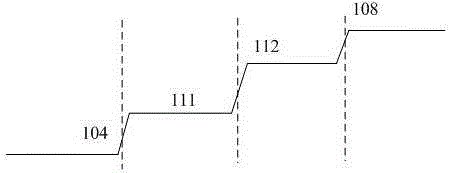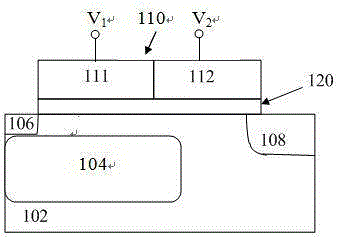Method for improving carrier transmission efficiency of backside illumination image sensor
An image sensor and transmission efficiency technology, which is applied in the field of image sensors, can solve the problems of affecting control flexibility, difficulty in free adjustment of step potential difference, and limitation of carrier transmission efficiency, so as to achieve the effect of improving response speed and image quality
- Summary
- Abstract
- Description
- Claims
- Application Information
AI Technical Summary
Problems solved by technology
Method used
Image
Examples
Embodiment 1
[0030] FIG. 1( a ) is a schematic structural diagram of a transfer transistor in a CMOS image sensor according to an embodiment of the present application. Wherein, the P-type substrate 102 may be a semiconductor substrate, or may include a semiconductor substrate and an epitaxial layer laid thereon, and the material of the semiconductor substrate may be a common semiconductor substrate material such as silicon, germanium, and gallium arsenide. A carrier collection region 104 with N-type doping is formed in the P-type substrate 102 to form a photodiode, which receives light incident from the bottom of the image sensor and generates photogenerated carriers. In this embodiment, the carriers are electrons. The carrier collection region 104 of the photodiode acts as the source of the transfer transistor. In addition, a floating diffusion region 108 with N-type doping is formed in the P-type substrate 102 , and the floating diffusion region 108 serves as the drain of the transfer ...
Embodiment 2
[0039] FIG. 2( a ) is a schematic structural diagram of a transfer transistor in a CMOS image sensor according to another embodiment of the present application. Wherein, the P-type substrate 102 may be a semiconductor substrate, or may include a semiconductor substrate and an epitaxial layer laid thereon, and the material of the semiconductor substrate may be a common semiconductor substrate material such as silicon, germanium, and gallium arsenide. A carrier collection region 104 with N-type doping is formed in the P-type substrate 102 to form a photodiode, which receives light incident from the bottom of the image sensor and generates photogenerated carriers. In this embodiment, the carriers are electrons. The carrier collection region 104 of the photodiode acts as the source of the transfer transistor. In addition, a floating diffusion region 108 with N-type doping is formed in the P-type substrate 102 , and the floating diffusion region 108 serves as the drain of the tran...
Embodiment 3
[0048] FIG. 3( a ) shows a schematic structural diagram of a transfer transistor in a CMOS image sensor according to another embodiment of the present application. Wherein, the P-type substrate 102 may be a semiconductor substrate, or may include a semiconductor substrate and an epitaxial layer laid thereon, and the material of the semiconductor substrate may be a common semiconductor substrate material such as silicon, germanium, and gallium arsenide. A carrier collection region 104 with N-type doping is formed in the P-type substrate 102 to form a photodiode, which receives light incident from the bottom of the image sensor and generates photogenerated carriers. In this embodiment, the carriers are electrons. The carrier collection region 104 of the photodiode acts as the source of the transfer transistor. In addition, a floating diffusion region 108 with N-type doping is formed in the P-type substrate 102 , and the floating diffusion region 108 serves as the drain of the t...
PUM
 Login to View More
Login to View More Abstract
Description
Claims
Application Information
 Login to View More
Login to View More - R&D
- Intellectual Property
- Life Sciences
- Materials
- Tech Scout
- Unparalleled Data Quality
- Higher Quality Content
- 60% Fewer Hallucinations
Browse by: Latest US Patents, China's latest patents, Technical Efficacy Thesaurus, Application Domain, Technology Topic, Popular Technical Reports.
© 2025 PatSnap. All rights reserved.Legal|Privacy policy|Modern Slavery Act Transparency Statement|Sitemap|About US| Contact US: help@patsnap.com



